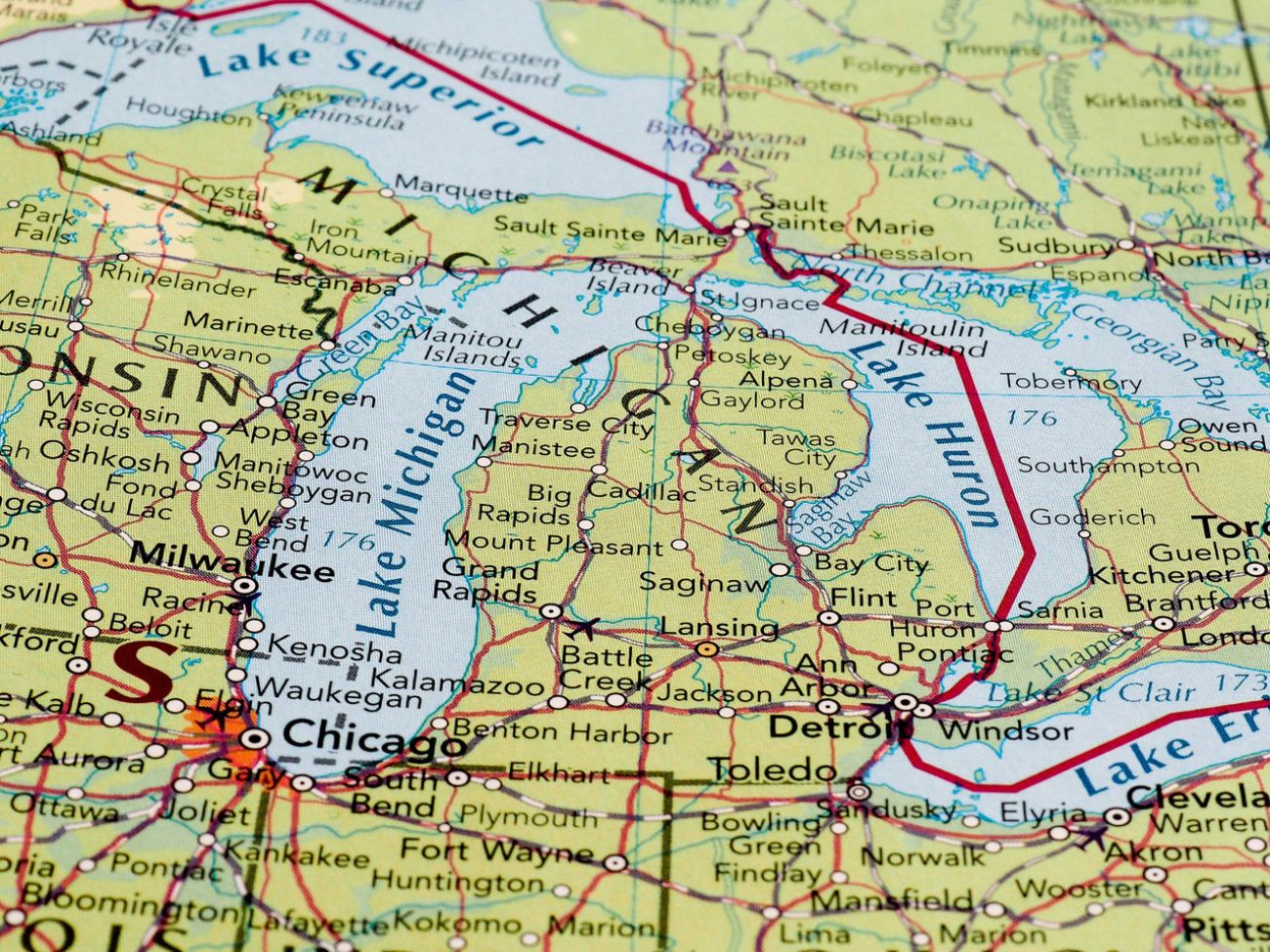Few coronavirus cases, lots of land. Should northern Michigan reopen?

Draw a line across Michigan from Lake Huron to Lake Michigan, just above Bay City, and you may begin to understand Judi Schwalbach’s frustration.
The area north of that line includes 41 of Michigan’s 83 counties, more than half of the state’s land mass, but just 9.2 percent of the state’s population and less than 2 percent of the COVID-19 cases and deaths.
As of Sunday, the area had 635 of the state's 43,000 cases and 51 of more than 4,000 deaths.
Schwalbach and thousands of others who live in northern Michigan are following social-distancing rules, but see few cases of the virus, leading to anger that prompted some to descend on Lansing, most recently Thursday, to protest Gov. Gretchen Whitmer’s economic restrictions during the pandemic.
Schwalbach, a former mayor of Escanaba in the central Upper Peninsula, said northern Michigan residents fear the virus and are taking common-sense distancing measures but are “resentful of a governor that’s not allowing us to be the adults we can be.”
“People are finding ways to be safe and smart, and be respectful of a virus that can be anywhere,” said Schwalbach, who works for state Sen. Ed McBroom, R-Vulcan.
Related:
- The latest: Michigan coronavirus map, curve, chart, updated COVID-19 news
- Michigan’s latest stay-home order to allow landscaping, boating and golf
- What Gov. Gretchen Whitmer’s stay-at-home executive order means to Michigan
- Maybe it's time to rethink allowing guns in Michigan Capitol, officials say
As Michigan starts its seventh week under a stay-home order, Whitmer is beginning to loosen business activity in the state. She recently allowed landscapers to return to work and golf courses to open. On Friday, she issued an executive order permitting the construction and real estate industries to reopen May 7, with restrictions.
The governor said the state’s gradual reopening for business will be based on health data and medical advice, the nature of industries and, in part, geography.
Whitmer’s team cautions that, although northern Michigan has fewer confirmed cases of the coronavirus, it also has far fewer hospital beds should a surge strike.
“We understand Michiganders are frustrated and they want to get back to work,” Bobby Leddy, a Whitmer spokesperson, told Bridge. “But we want to keep everyone safe.”
Speaking Sunday on “Meet the Press,” Michigan Chief Medical Executive Dr. Joneigh Khaldun said that infections are gaining steam outside southeast Michigan, even as the overall caseload statewide has plateaued.
"If we don't do well with these social distancing measures, more people will die and that is just the facts," she said.
Whitmer has divided the state into regions and said she will make decisions on what to reopen and when based on COVID-19 case counts, the capacity of each region’s hospitals and the state’s ability to track infected people.
Bridge analyzed a host of data in each region, from testing and unemployment to intensive care beds. With more than 1 million residents out of work because of the virus, unemployment rates actually are among lowest in the Upper Peninsula, which is the least affected by the coronavirus.
Whitmer last week extended the closure of restaurants and her state of emergency to May 28.
If businesses are able to open by then, the tourism-dependent Upper Peninsula would be able to have “some sort of summer,” said Connie Litzner, mayor of St. Ignace in the eastern Upper Peninsula.
“I wouldn’t want it to go any longer,” she said, adding that she agrees with Whitmer’s gradual approach and believes plans to loosen restrictions should account for differences between downstate and northern Michigan.
“We still have to be very cautious, but we also have to get back to work,” said Litzner.
Even when businesses reopen, they likely have numerous restrictions, including far less seating at restaurants and mandatory masks, distancing and other measures at businesses.
Sen. Ken Horn, R-Frankenmuth, said Whitmer needs to be more open about what benchmarks Michigan needs to meet before businesses can reopen to give them time to prepare.
“Manufacturing is ready to go now, and can do it safely,” said Horn, who helped author a plan by Senate Republicans to relaunch Michigan’s economy in five phases depending on a host of factors, including regional differences.
“But there’s a frustration on the lack of clarity [from Whitmer] and how these decisions are made? What is the matrix?”
Read more: Opinion | Guns and screaming at Michigan Capitol drown out message of protest
Whitmer has carved up the state into regions to prioritize reopening in ways that sometimes don’t make sense, Horn said.
Lapeer County is 60 miles north of Detroit and has fewer than 200 cases, but because it’s in the same region, its businesses will be treated the same as those in Detroit and Wayne County, which have more than 17,000 cases.
As of this weekend, only one coronavirus patient was hospitalized in the Upper Peninsula, but the entire region only has 700 acute care beds compared to 14,000 in southeast Michigan, according to state records.
Joshua Petrie, a research investigator in the epidemiology department at the University of Michigan School of Public Health, said the cases-to-capacity ratio in the Upper Peninsula makes it among the state’s best candidates for “a hard look” at gradually loosening restrictions. He cautioned that “you’d have to be really careful” not to open too much too soon.
Litzner, the St. Ignace mayor, said she’s comfortable with the UP’s hospital bed and ventilator capacity, since systems in other parts of the state have shared resources. When a Mackinac Island resident recently fell ill with COVID-19, Petoskey’s McLaren Northern Michigan Hospital took them in, she said.
“With everybody pitching in, I think we’ll be fine,” she said.
But talk of reopening too quickly causes anxiety for northern Michigan public health officials, said Erin Johnson, disease control and prevention program supervisor with the Grand Traverse County Health Department.
As restrictions loosen and more people begin mingling in public, the chances of a new outbreak increase, Johnson said.
“I would urge people to be very cautious in their approach to heaving back out into their normal lives and pushing for everything to open up so quickly,” Johnson said. “It really needs to be, as the governor said, a very cautious approach.”
Speaking Sunday on CNN, Whitmer said Michigan should be testing 1 percent to 2 percent of its population each week, and “we are far short of that,” partly because of trouble accessing the supplies needed to conduct tests.
Though testing has risen dramatically in the past week, the state is still testing less than 1 percent of its population weekly, through Saturday. Southeast Michigan came closest with nearly 29,000 tests but it was still just 0.6 percent of the region’s 4.6 million people.
Petrie, the U-M epidemiologist, cautioned that rural health systems have far less capacity than urban counterparts to conduct robust training and contact testing. With fewer public health professionals available to keep tabs on a much larger geographical area, new cases may go undetected for longer, enabling the virus to spread in the interim.
“You don’t want to get to the point where you’re only figuring out you have a problem because people are dying,” Petrie said.
Below is a closer look at how the virus is progressing in different parts of the state.
See what new members are saying about why they donated to Bridge Michigan:
- “In order for this information to be accurate and unbiased it must be underwritten by its readers, not by special interests.” - Larry S.
- “Not many other media sources report on the topics Bridge does.” - Susan B.
- “Your journalism is outstanding and rare these days.” - Mark S.
If you want to ensure the future of nonpartisan, nonprofit Michigan journalism, please become a member today. You, too, will be asked why you donated and maybe we'll feature your quote next time!




